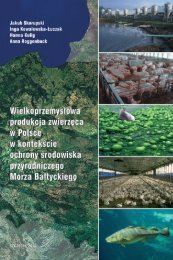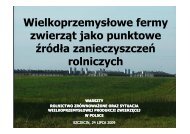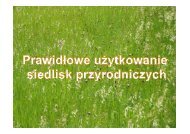best available technologies for manure treatment - Baltic Green Belt
best available technologies for manure treatment - Baltic Green Belt
best available technologies for manure treatment - Baltic Green Belt
You also want an ePaper? Increase the reach of your titles
YUMPU automatically turns print PDFs into web optimized ePapers that Google loves.
Best Available Technologies <strong>for</strong> <strong>manure</strong> <strong>treatment</strong> baltic sea 2020<br />
ANNEX K: KEY ELEMENTS OF DANISH LEGISLATION IN RELATION TO N AND P LEACHING<br />
ANNEX K: KEY ELEMENTS OF DANISH LEGISLATION<br />
IN RELATION TO N AND P LEACHING<br />
Policies<br />
Denmark had, due to developments in nitrate levels<br />
of the ground water, already taken decisions in 1985<br />
on policy goals and introduced legislation to implement<br />
these goals. EU’s Nitrates Directive was issued<br />
first six years after, heavily inspired of the instruments<br />
that were already taken into use in Denmark to<br />
reduce leaching:<br />
• relation between the livestock <strong>manure</strong> production<br />
and the agricultural land;<br />
• required storage capacity <strong>for</strong> livestock <strong>manure</strong>; and<br />
• restrictions on spreading time <strong>for</strong> livestock <strong>manure</strong>s.<br />
In order to ease the introduction of the regulations<br />
in a pedagogic and understandable way there was<br />
defined a so-called Animal Unit, by which it without<br />
respect to animal type, feed intensity, production<br />
system, bedding type or other is possible to precisely<br />
define the requirement to the relation between<br />
agricultural land and the livestock production. 1<br />
Animal Unit was determined to 100 kg N ex. storage,<br />
and shall not be mixed with other conversion factors<br />
<strong>for</strong> livestock, <strong>for</strong> instance the Large Livestock Units,<br />
which most countries uses, and where 1 cow is 1<br />
Large Livestock Unit, but which has no connection<br />
to the environmental load of the livestock.<br />
The policy plans during the years in relation to<br />
leaching is seen from the table below.<br />
The latest policy plan is the “<strong>Green</strong> Growth Plan”,<br />
which has been issued by the Danish Government<br />
in April 2009. The plan sets the goal of reducing the<br />
leaching with 210.000 ton N and 19.000 ton P latest<br />
Year Plan Significant elements in legislation:<br />
1985 NPO-plan<br />
- regulation of allowed animal units per ha<br />
- min. storage capacity <strong>for</strong> animal <strong>manure</strong><br />
1987 Water Environment Action Plan I<br />
- 50% reduction in N-leaching from agr.<br />
- 65% ”autumn green fields”<br />
- Slurry in autumn only to winter covered fields<br />
- Slurry only to grass or oilseed rape in autumn<br />
1992 Sustainable agriculture<br />
- Max. N-standards <strong>for</strong> crops (N-quota per farm)<br />
- Min. utilization of N in animal <strong>manure</strong><br />
- Fertiliser plans and -accounts.<br />
1998 Water Environment Action Plan II<br />
- 10% decrease of N-standards (The N-quota)<br />
- 6% ”super” green fields in autumn<br />
- 15% higher utilization of N in animal <strong>manure</strong><br />
2005 Water Environment Action Plan III<br />
- 50% reduction of the P leaching<br />
- 13% reduction of the N leaching<br />
96








